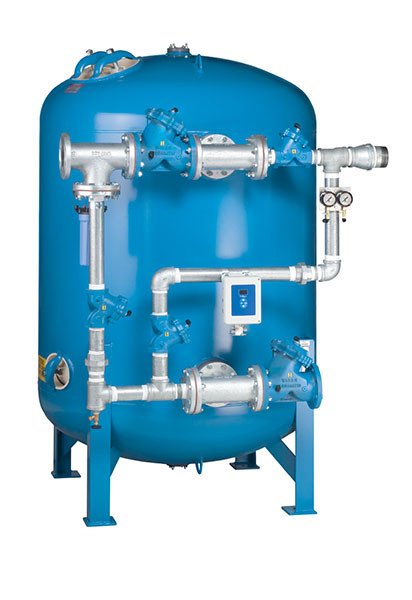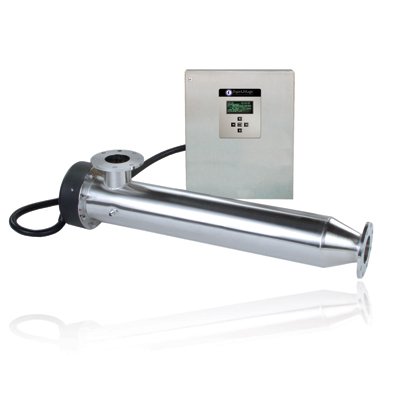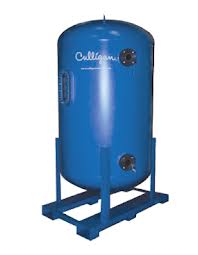Commercial & Industrial Products
Worldwide Leader
Products
Meredith's Culligan water company serves a variety of businesses—both commercial/retail establishments all the way to heavy industrial complexes in our service areas!
Culligan is a worldwide leader in the distribution of water softeners, water filters, reverse osmosis, deionization, electro-deionization (EDI/CDI), and virtually every other water technology and treatment system available for business, commercial and industrial use.
We have a full time staff of personnel with over 100 years of accumulated experience in water treatment. Our local individuals have the experience to engineer, design and specify virtually all types of water treatment systems for any application. We have state licensed installers and factory trained service personnel. After installation, preventive maintenance contracts and full service contracts are available on all products. In other words, we offer turnkey services for entire projects.

Culligan® Commercial & Industrial Continuous Electrodeionization
Electro-deionization (EDI), continuous electronic deionization (CEDI) or continuous deionization (CDI) all refer to the same water treatment technology. EDI utilizes a combination of membranes and ion exchange resins to produce very high quality water without the need for chemical regeneration.
An EDI system has modules, which are also called stacks, typically frames in parallel water flow configuration. Each stack has cell pairs of both anodes and cathodes, anion and cation selective membranes and a bed of ion exchange resins. The stacks are separated by screens.
In the EDI process, the resin separates dissolved ions at the top of the cell. With a current applied across the stack, the respective ions are drawn through the selective membranes toward the electrodes. Due to the ion selectivity membranes, each type of ion migrates to their respective spaces, which are called concentrate channels. The concentrated ions in the channels are then flushed to drain. With proper pre-treatment and system design/engineering, EDI is capable of producing large volumes of very high quality DI water.

The Culligan Side Mount (CSM™) Series Water Softener System
Efficient and Scalable Heavy-Duty Water Treatment System
Use Culligan® equipment to help meet the highest standard of water quality at your facility. The Culligan® Side Mount heavy-duty softener reduces hard water contaminants*, even for large flow volume applications, reducing scale buildup that can affect equipment performance. The Culligan®-exclusive Smart Controller allows you to efficiently set up and manage your water treatment. Using optional accessories, monitor water usage data, such as the flow rate and volume, and regenerate the system as needed, saving resources and money.
The CSM softener is part of the Culligan® Commercial and Industrial Solutions that combine durable and efficient equipment, systems experience and technical experts who understand your unique requirements. From planning your system to installing your water treatment equipment, Culligan® Commercial and Industrial Solutions offer options that help deliver the quality of water to meet your needs. Contact Culligan® today to learn more about the CSM softener system.

Culligan® Commercial & Industrial Filtration Systems
Culligan offers a wide range of filtration technologies, products and services to meet the water quality and quantity needs of our customers with high purity water applications.
Carbon (Activated Adsorption) Filtration
Filtering water with carbon is one of the oldest means of water purification dating back to 200 BC. Each carbon particle is porous and is designed to provide a large adsorption surface area. The carbon is made from a wide variety of base materials, such as wood, coconut shell, coal and petroleum. These materials are activated and processed using different techniques resulting in different performance specifications and characteristics.
Carbon filters are most widely used for the removal of chlorine and to reduce/remove tastes, colors and odors. But, depending on which carbon is chosen, a wide variety of VOCs (volatile organic carbons), sediments and other halogens may be adsorbed. Carbon does not remove ions, such as calcium, magnesium or sodium, or bacteria and other living organisms. Some specific carbons are able to adsorb lead and other heavy metals.
Ultrafiltration & Nanofiltration (Microfiltration)
Both ultra-filtration and nano-filtration utilize semi-permeable membrane technology. The differences in performance of membranes are based on pore sizes of the surface. Nano-filtration membrane pore size is larger than RO, but smaller than ultra-filters. Depending on the material and manufacturer, nano-filters can remove suspended solids and between 50% and 90% of dissolved ions. Ultra-filter membrane pore size is smaller than micro-filters, but larger than nano-filters. Ultra-filters also remove a range of suspended solids, but have no capacity for ion reduction/removal.
Depending on the need and application, nano-filtration and ultra-filtration can provide the best possible water quality in the most efficient way. They both require lower feed pressures than reverse osmosis, yet yield higher permeate flows. The purity is higher with reverse osmosis, however. Due to their construction, these (ultra and nano filters) membranes are much less susceptible to fouling or plugging and require less sophisticated pre-treatment equipment.
Depth (Multi-Media) Filters
The use of "media filters" for making water clearer has been dated back to ancient times - dense materials, such as sand, would trap much of the suspended particles in the water, leaving the resulting water clearer and cleaner looking. Today's multi-media filters still use the same basic principle. However, multiple (typically 3 or 4) different types and sizes of medias are used. By using progressively smaller and/or heavier media from top to bottom in a vessel, it's possible to remove much higher volumes and much smaller particles. The larger particles get trapped in the upper media of the vessel with the smaller sizes being trapped in the progressively lower, finer and heavier media.
By following this technology and design, it becomes possible for one vessel to filter much more volume of solids. Also, the "service run"- or time that the filter operates- between backwashes can be significantly extended. When the filter backwashes, the trapped particles are "purged" from the vessel and the filter is again ready to do its job.

Culligan® Commercial & Industrial Water Softeners
Culligan® Ion Exchange Water Softeners remove hardness from water and are one of the most widely known and used types of water treatment technologies. The term "hardness" in water refers to the presence of dissolved calcium and magnesium. Hardness is most commonly measured in grains per gallon and "Soft" water is generally defined as having 1 grain per gallon or less. As the quantity of hardness increases, the amount of only moderately soluble calcium and magnesium also increases and will form scale deposits. These deposits build up on nearly any surface the water contacts - water heaters, boilers, cooling towers, valves, faucets, piping and more.
A water softener softens by using ion exchange resin. Resin is a synthetic plastic material manufactured in tiny bead form. The bead is porous and has billions of exchange sites on its huge surface area. These sites have an affinity (or attraction) to metals (particularly +2 and +3 valences). When water flows over the beads (resin), metals in the water are attracted to the resin and, if recharged with sodium, will be held to the resin. The metals are more highly attracted than sodium and take their place on the resin beads. Thus, in the process, sodium ions are released into the water. Through this process, the water exiting a softener is virtually void of hardness - but does have an increase in sodium level.
Most often, a water softener has two tanks with a controller. The resin tank must have adequate volume of resin and must be large enough to provide soft water at up to peak flow rates of the application. The controller governs and operates the system for consistently soft water. The brine tank provides brine for each regeneration and storage for multiple regenerations of the water softener. Quality softeners will also have a double safe overflow prevention valve inside the brine tank. Depending on the application, there are many different system configurations using multiple tanks and controls.
Water softeners are effective in the virtual elimination of problematic and costly scale build-up. They reduce the need for more costly chemicals, cleaners and de-scaling compounds. And, at the same time, save on energy consumption in boilers, water heaters, cooling towers and other processes.

Culligan® Commercial & Industrial Reverse Osmosis Systems
A reverse osmosis water treatment system is used to economically produce water with low total dissolved solids (TDS). It is often the best and lowest cost per gallon choice of any treatment option especially if large volumes of low TDS water are needed.
Osmosis is a natural process. If you have two fluids separated by a semipermeable membrane, the fluid having the lesser concentration will naturally flow through the membrane to the higher concentration side. In general, as the fluid passes through the membrane, water will pass and minerals will not. A natural, simple example is the roots of a tree.
In a reverse osmosis system, higher pressure is applied to the higher concentration side of a man-made semi-permeable membrane and water (H2O) will flow through with the minerals being "washed" to drain. Using this technology, low TDS (total dissolved solids) water is produced and, with the flow to drain, a membrane can perform for a very long time before needing replacement. The other key to membrane longevity is proper pretreatment of the feed water.
Reverse osmosis systems are of various sizes/volumes as big as those supplying water to whole communities/cities and very large manufacturers', but also for a family's drinking water.

Commercial & Industrial Ultraviolet (UV) Water Treatment
Bacteria is present in virtually all- if not absolutely all- water systems. The complete and consistent elimination of all bacteria is nearly impossible. However, with the use of UV (ultraviolet) water sterilization, bacteria can be controlled and reduced to a very low level.
Some types of bacteria are health harmless and create no real issues. There are also some types of bacteria that can cause illness, foul odors, slime build-up and obnoxious tastes to water. In the cases of high purity water (and ultra-pure) systems, keeping a very low level of bacteria is imperative and often required in order to meet water quality (ASTM, MCCLS, CAAP, AAMI) specifications.
All living organisms have deoxyribonucleic acid (DNA) that provides the instructions for all functions in that organism. A UV (Ultraviolet) water sterilizer emits ultra-violet light into the water stream at a sufficient dosage as to disrupt and/or destroy the functioning of genes and the DNA in living organisms. Certain specific types of UV sterilizers also control and reduce the overall total organic carbon (TOC) levels in the water as well.
In order for a UV (Ultraviolet) system to provide proper performance, there has to be sufficient dosage. The dosage is a function of wavelength, intensity and exposure time. Further, other considerations such as pre-treatment, flow rates and level of contamination, for instance, are all important in getting the desired results.

Culligan® Commercial & Industrial Dealkalizers
Water typically has a certain amount of alkalinity present. The alkalinity is normally hydroxide, carbonate and/or bicarbonate- which are all pH dependent. Depending on the overall water characteristics, when heated, the water can become corrosive. This corrosiveness creates problems especially in the case of boiler operations.
A de-alkalizer reduces the alkalinity in water by the use of ion exchange. A bed of anion resin is regenerated/recharged by a brine solution and the exchanged ion is chloride. If the application also requires carbon dioxide, reduction, caustic feed is added and combined with the brine solution during regeneration. If de-alkalization is being used for boiler feed, it is often that there is a duplex (twin) system application for 24 hour availability of de-alkalized water. In the case of boiler feed, and since most water supplies have a presence of hardness (which can foul anion resin), de-alkalizers are preceded by the necessary water softening system to reduce/eliminate hard water scaling.

Culligan® Commercial & Industrial Portable Exchange Deionizers
A deionizer produces very low total dissolved solids (TDS) water for very high quality and/or ultra-pure water needs.
Deionization is an ion exchange process using synthetic plastic beads. There are two different types of resin beads - cation resin, which has an affinity for positively charged ions and anion resin, which has an affinity for negatively charged ions. When the cation resin is "recharged" with an acid bath regeneration, the hydrogen ion becomes "attached" to the resin beads. In the case of the anion regeneration, sodium hydroxide (caustic soda) is used and the hydroxyl ion becomes "attached". In both the cation and anion resins, they have the lowest affinity for those ions. When water containing virtually any other ions flows over the resin beads, they will release the hydrogen and hydroxyl ions and attach (remove) virtually all other ions.
Deionizers are typically configured in a dual bed or mixed bed arrangement. The dual bed systems will have two separate tanks- one with only cation resin, and one with only anion resin. In the very highest quality and/or ultrapure water applications, mixed beds (uni-beds) are commonly used. These tanks contain a mixture of both cation and anion resins in one vessel. In so doing, a much higher quality/purity of water is produced.
In many cases and applications, portable exchange deionization service makes the most sense, due to the following advantages:
- Eliminate on-site chemical storage and handling
- No permanent plumbing/installation
- Portable tank size and configuration can be easily and economically changed as volumes and quality needs change
- No capital expenditures required on long-term equipment or hardware
- No hazardous waste or regeneration effluent
Deionization and deionized water can also be supplied by an in-plant system. These systems automatically regenerate on a pre-set frequency or are manually initiated and complete the operation automatically.

Skid-Mounted Systems
Culligan offers a wide array of skid-mounted products and options. Skid-mounted systems reduce field labor and installation expense. These systems are custom-designed to fit your needs. All equipment is skid-mounted, pre-piped and pre-tested at our facility. Ongoing monitoring can be performed by your on-site personnel, or we can monitor your system remotely.

